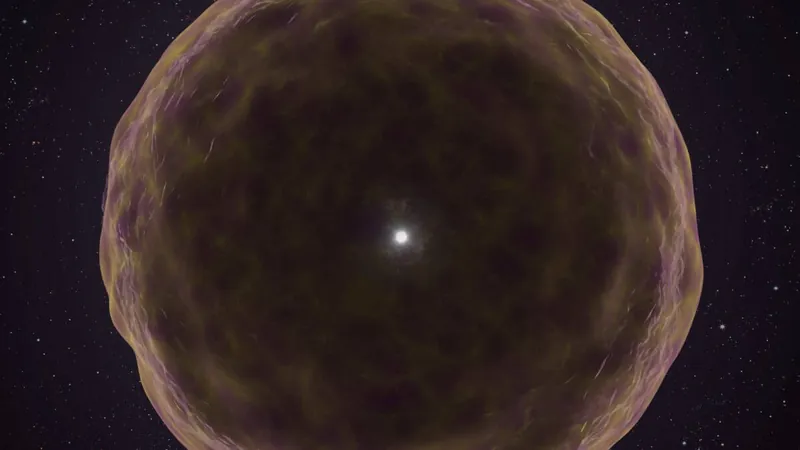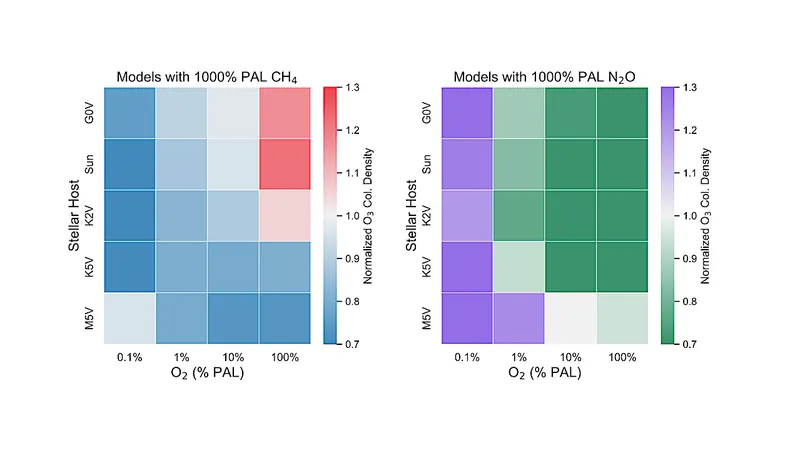
Cosmic Revelation: Astronomers Capture Stunning Evidence of a Stripped Star's Supernova
2025-08-28
Author: Daniel
Astronomers Make Groundbreaking Discovery of Heavily Stripped Star
In an awe-inspiring breakthrough, astronomers have for the first time deciphered the spectral evidence of a heavily stripped star, one that has shed its outer layers just before meeting its fiery end in a supernova explosion. Spearheaded by Steve Schulze at Northwestern University, this remarkable discovery reveals heavier elements that are typically hidden deep within the stellar core.
The Lifecycle of Stars: A Dance of Nucleosynthesis
Inside stars, the process of nucleosynthesis reigns supreme as atomic nuclei fuse together to forge heavier elements. This monumental fusion not only produces a treasure trove of elements but also unleashes immense energy that combats the gripping force of gravity. As stars mature, they consume and generate various elements, transitioning from hydrogen at birth to helium, and eventually to carbon and iron as they near their end.
The Onion Layer Structure of Aging Stars
Aging stars resemble onions, layered with hydrogen on the outside and progressively heavier elements toward the core. As these celestial giants near their demise, they form an iron core, which has a peculiar property: it consumes energy during fusion rather than releasing it. This energy drain leads to an inevitable collapse under gravity, culminating in a spectacular supernova explosion.
Unveiling Hidden Elements in Supernovae
It’s an extraordinary event when astronomers catch a glimpse of a star that has lost its outer layers before exploding. During these dramatic supernova events, heavier elements concealed within the star’s depths reveal themselves through absorption lines in light spectra, providing essential clues about their composition.
Mysterious SN 2021yfj: A Stellar Investigation
In September 2021, while scanning for infant supernovae in their earliest stages, the Zwicky Transient Facility made a puzzling discovery: SN 2021yfj. Schulze recounts the excitement of noticing its unexpected brightness, leading the team to collaborate with experts at the University of California, Berkeley for deeper analysis.
When the spectrum results returned, the team was stunned. Many features were unlike any they had seen before, primarily attributed to silicon, sulfur, and argon—elements usually trapped beneath layers of other materials.
Confirming the Discovery: A Cosmic Treasure Trove
By employing multiple ground and space-based telescopes to observe SN 2021yfj, the team ultimately confirmed their findings. They had unearthed a supernova shrouded in a shell heavily enriched with silicon, sulfur, and argon, elements that are only generated shortly before a star’s death.
A New Chapter in Stellar Evolution
This discovery of SN 2021yfj marks a pivotal moment in astronomy, revealing that some stars undergo much more extreme transformations before their final bow. Schulze notes, “This event emphasizes that our current understanding of stellar evolution is still incomplete.” As researchers dive deeper into this cosmic enigma, they hope to unravel further mysteries of the star lifecycle and the dramatic phenomena that herald their ends.

 Brasil (PT)
Brasil (PT)
 Canada (EN)
Canada (EN)
 Chile (ES)
Chile (ES)
 Česko (CS)
Česko (CS)
 대한민국 (KO)
대한민국 (KO)
 España (ES)
España (ES)
 France (FR)
France (FR)
 Hong Kong (EN)
Hong Kong (EN)
 Italia (IT)
Italia (IT)
 日本 (JA)
日本 (JA)
 Magyarország (HU)
Magyarország (HU)
 Norge (NO)
Norge (NO)
 Polska (PL)
Polska (PL)
 Schweiz (DE)
Schweiz (DE)
 Singapore (EN)
Singapore (EN)
 Sverige (SV)
Sverige (SV)
 Suomi (FI)
Suomi (FI)
 Türkiye (TR)
Türkiye (TR)
 الإمارات العربية المتحدة (AR)
الإمارات العربية المتحدة (AR)